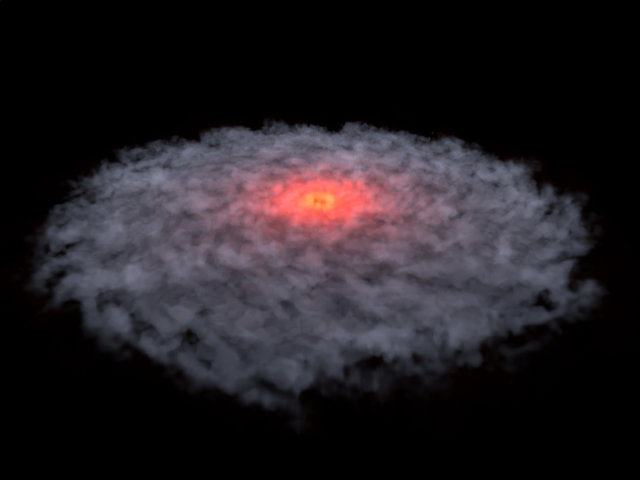Orphan Planet's Huge Disk Shows That Planets Are More Like Stars Than We Know

The lonely life of OTS44, an orphan planet floating in space without a parent star, has taken a mysterious turn.
New observations with the Atacama Large Millimeter/submillimeter Array (ALMA) radio telescope in Chile show that the planet, located about 550 light-years away from Earth in the constellation Chamaeleon, is surrounded by a protoplanet-like disk of gas and dust — which is a distinctive feature of young stars, not planets. (Rings surrounding planets like Saturn are likely the result of smashed moons, not part of the planet-formation process.)
Even more puzzling to astronomers, OTS44 is actively siphoning material from its disk to make itself larger, a very star-like development process. The planet is a puny 1 percent the size of our sun, and about 10 times bigger than Jupiter.
Lead author Amelia Bayo, with the University of Valparaiso in Chile, and colleagues from Germany, the United States, China, Ireland, Italy, the United Kingdom, France, and Chile published their findings in last week's issue of Astrophysical Journal Letters.
Current theories derived from computer models and astronomical observations indicate that a star and its planets form from a collapsing cloud of dust and gas within a larger cloud know as a nebula, according to the Space Telescope Science Institute in Baltimore.
"As gravity pulls material in the collapsing cloud closer together, the center of the cloud gets more and more compressed and, in turn, gets hotter," says the institute's Hubble Space Telescope website. "This dense, hot core becomes the kernel of a new star."
Meanwhile, the collapsing cloud is churning, causing it to compress and begin rotating in the same direction. Eventually the cloud flattens into a disk that gets thinner as it spins, "kind of like a spinning clump of dough flattening into the shape of a pizza," the institute says. "These disks… are the birthplaces of planets."
Get the Space.com Newsletter
Breaking space news, the latest updates on rocket launches, skywatching events and more!
With much of the gas siphoned off by the developing star, rocky material collects in the inner part of the disk, forming miniature planets that over time meld together into larger rocky planets.
Farther away in the disk, ices that haven’t been vaporized by the star and more gas combine to form giant gas planets.
But OTS44 defies conventional theory. The latest research shows that the relatively small OTS44 has a disk containing more than 10 times the mass of Earth, and that it is actively accreting material.
"It is amazing how an observatory like ALMA allows us to see half an Earth mass worth of dust orbiting an object with ten times the mass of Jupiter at a distance of 500 light-years," Thomas Henning of the Max Planck Institute for Astronomy noted in a press statement. "But the new data also shows the limit of our understanding."
RELATED: Young Galaxy's Old Stardust Sheds Light on the First Stars
The ALMA observations also show that OTS44's disk contains unexpectedly large dust grains that are about 1 millimeter (.04 inches) in diameter. Low-mass objects like OTS44 are not expected to generate conditions where dust grains can clump together to reach this size.
Indeed, the research team noted that the dust grains orbiting OTS44 seem to be growing, and speculated that they might possibly end up cohering into a mini-moon.
The discovery suggests that stars and planet-like objects are more similar than previously thought, Bayo remarked.
"The more we know about OTS44, the greater its similarities with a young star," she said. "But its mass is so low that theory tells us it cannot have formed like a star!"
Originally published on Seeker.
Join our Space Forums to keep talking space on the latest missions, night sky and more! And if you have a news tip, correction or comment, let us know at: community@space.com.

Irene Klotz is a founding member and long-time contributor to Space.com. She concurrently spent 25 years as a wire service reporter and freelance writer, specializing in space exploration, planetary science, astronomy and the search for life beyond Earth. A graduate of Northwestern University, Irene currently serves as Space Editor for Aviation Week & Space Technology.










